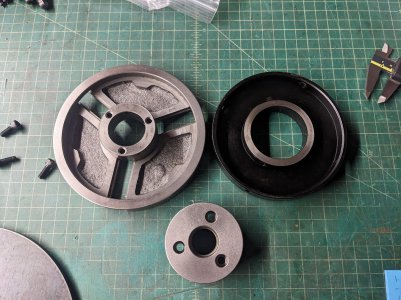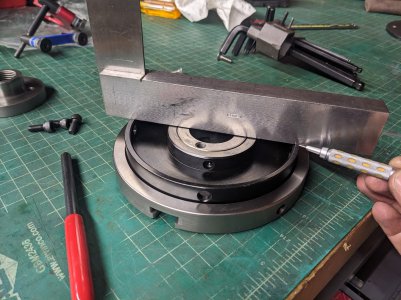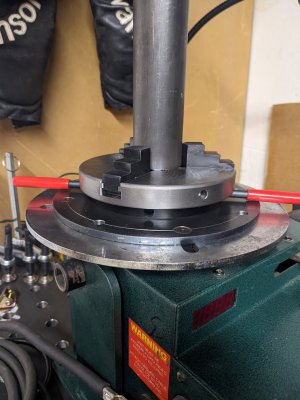- Joined
- Jun 10, 2019
- Messages
- 537
Was browsing Grizzly for a lathe chuck when I came across this 6" woodworking lathe chuck.


Its operated by putting a pin into the scroll body (the black part) and another pin in the chuck body; you then pull/push on the pins to turn the scroll.
Looking at how its made: I was thinking this would be easy to modify to mount to a rotary positioner. Because rotary positioners spindles lock up when off: all you'd need is to operate it would be to turn the scroll (no need to hold the chuck, exactly like a speed chuck). Nice Profax speed chucks are $500; that Grizzly chuck is less than $50.
That rear retaining plate does remove easily which makes simple work to mount the chuck directly to an adapter plate for the rotary positioner. M5 bolts on a 45mm PCD for this particular chuck. The face of the outer ring of the scroll body has to be machined down ~0.026 so it won't interfere with the adapter plate (it has to be a hair lower than the chuck so that the scroll can spin).


As a quick solution for the handles (pins): I welded 1/4-20" nuts to the inside of the scroll and threaded the ends of the handle pins so that they can stay attached to the scroll. It works better than I expected. Even though the handles are light, you can swing the handle and the jaws clamp down well from the inertia. Having more weight would probably work a bit better, but not strictly necessary. So if you're looking for a relatively inexpensive speed chuck option: this one works great - faster and much lower profile than a traditional lathe chuck.



Its operated by putting a pin into the scroll body (the black part) and another pin in the chuck body; you then pull/push on the pins to turn the scroll.
Looking at how its made: I was thinking this would be easy to modify to mount to a rotary positioner. Because rotary positioners spindles lock up when off: all you'd need is to operate it would be to turn the scroll (no need to hold the chuck, exactly like a speed chuck). Nice Profax speed chucks are $500; that Grizzly chuck is less than $50.
That rear retaining plate does remove easily which makes simple work to mount the chuck directly to an adapter plate for the rotary positioner. M5 bolts on a 45mm PCD for this particular chuck. The face of the outer ring of the scroll body has to be machined down ~0.026 so it won't interfere with the adapter plate (it has to be a hair lower than the chuck so that the scroll can spin).


As a quick solution for the handles (pins): I welded 1/4-20" nuts to the inside of the scroll and threaded the ends of the handle pins so that they can stay attached to the scroll. It works better than I expected. Even though the handles are light, you can swing the handle and the jaws clamp down well from the inertia. Having more weight would probably work a bit better, but not strictly necessary. So if you're looking for a relatively inexpensive speed chuck option: this one works great - faster and much lower profile than a traditional lathe chuck.

Last edited:
